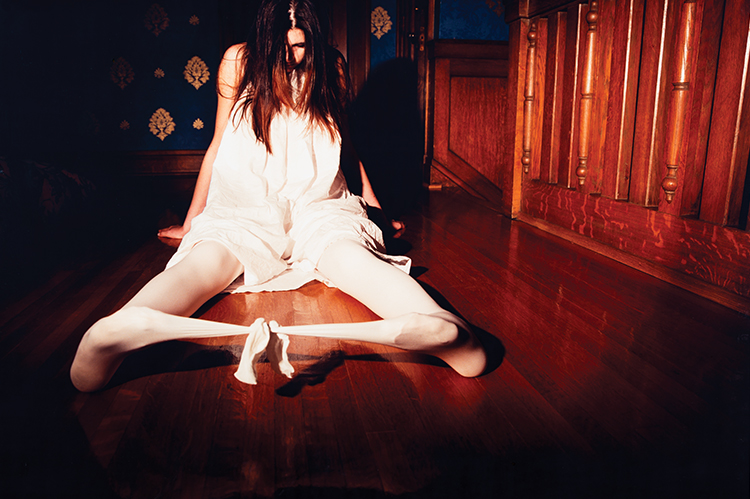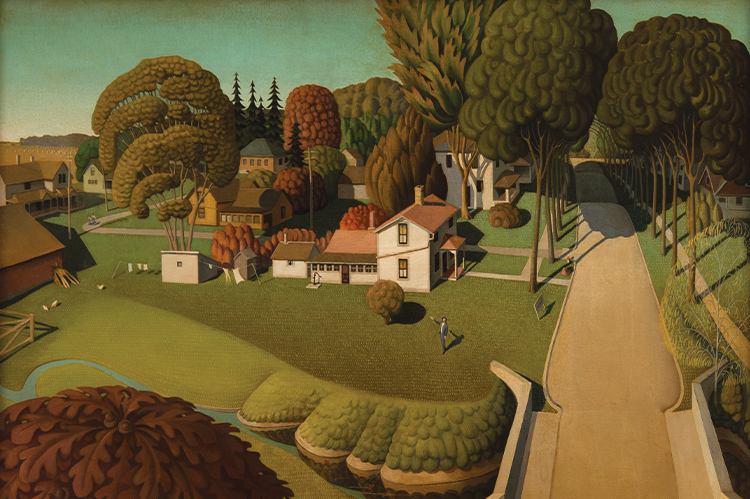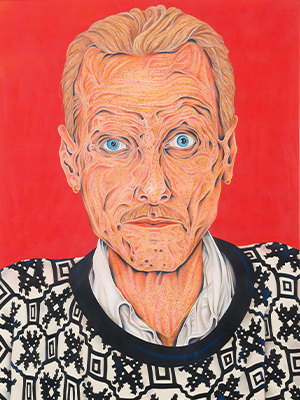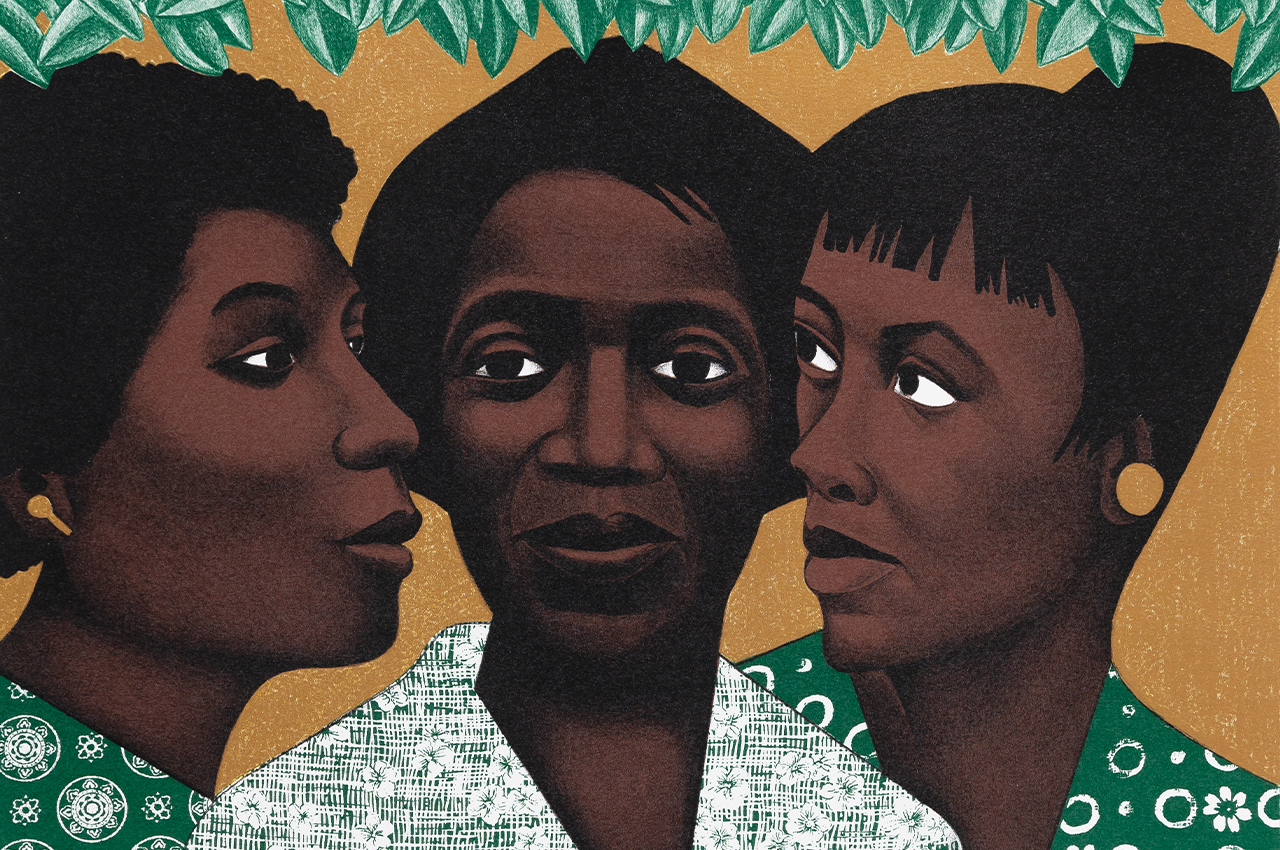Elizabeth Catlett created abstract and figurative works that depicted the Black female experience. Intrigued by the work of Grant Wood, she enrolled in the graduate program at the University of Iowa, where he taught. Wood advised her to focus on creating images of what she knew best, leading her to focus on Black women and children. Catlett graduated from Iowa in 1940 as the first Black woman to earn an MFA from the university. The Washington, D.C., native died in 2012. Elizabeth Catlett (1915-2012), “Links Together,” 1996; lithograph on paper; Des Moines Art Center Permanent Collections.
Writer: Christine Riccelli
Photographer: Rich Sanders
About two years ago, Des Moines Art Center Director Jeff Fleming was pondering how to mark a milestone anniversary of the museum in 2023. “We started thinking, how do we celebrate 75 years? What is the appropriate way to do it? “What I wanted was to celebrate the Art Center, of course, but more importantly to celebrate the community in which we live because we don’t exist without the community,” adds Fleming, who joined the Art Center in 1999 and will retire in April after serving as director since 2005 (see story, here). “That was very important to me.”
Part of celebrating the community, Fleming and his team decided, is to celebrate the artists who are in it. Fleming points out that since its founding in 1948, Iowa artists have been key to the museum’s identity, playing a major role not only in connecting the Art Center to the community but also in enriching the state’s creative culture. The museum has long been committed to showcasing Iowa artists, including presenting the annual “Iowa Artists” series that began in the early 1950s.
Thus, the institution will kick off the anniversary with “Art Center: 75 Years of Iowa Art,” curated by Laura Burkhalter and Mia Laufer. The exhibit, which opens Feb. 10 and runs through May 7, will feature some 100 works by about 60 artists who have lived and worked in Iowa from the early 20th century to today. They’ll range from such iconic artists as Grant Wood to lauded contemporary artists such as Anna Gaskell, Mitchell Squire, Larassa Kabel and Phillip Chen.
The exhibit’s paintings, sculptures, watercolors, mixed-media pieces, lithographs, pastels, drawings and photographs showcase a variety of styles and cover a broad range of subjects. Along with traditional Iowa landscapes, for example, you’ll find provocative works exploring such issues as racism and gender exploitation.
In addition, newly commissioned works, including a piece by Meskwaki painter Duane Slick, and performance art will also be featured. Artist and educator Firat Erdim, for example, plans to do four performance-based works during the run of the show. As part of the larger anniversary celebration, acclaimed artist Oyoram will illuminate the exterior of the Meier wing with a projection; at press time, the date hadn’t been determined. (Click here to read more on Oyoram and here for more on Erdim.)

Des Moines native Anna Gaskell, who currently lives in New York, is a photographer whose works are influenced by films and painting. She stages the scenes depicted in her photographs, using a narrative style that seeks to tell stories as opposed to capturing a realistic event.
Anna Gaskell (born 1969), “Untitled #35 (hide),” 1998; C-Print; Des Moines Art Center Paul and Anastasia Polydoran Collection.
The Umbrella Philosophy
The Art Center “works hard to lift up Iowa artists and showcase them and their special gifts to the world,” says board of trustees member Rosemary Parson. “With that and the combination of national and international art, you really have the full spectrum of art at its finest.”
She likens supporting Iowa artists to the “umbrella philosophy. If you raise the umbrella first, you can place other individuals and items under it. If you don’t, everyone will get wet. Iowa artists are the ribs of the umbrella.”
Artist Philip Chen, a professor of drawing and printmaking at Drake University, and his wife, Lenore Metrick-Chen, associate professor of art history at Drake, moved here in 1995 from Chicago. “My first baptism here, so to speak, was going to an Iowa artists show at the Art Center,” he says. “It was so impressive to me that the museum was hosting that kind of event to support local artists. … Over the years, the Art Center has kept that commitment.”
He adds that major art institutions in Chicago didn’t support local artists the way the Art Center does. In fact, Chen says, even though he and Lenore had job offers in Boston and Honolulu at the time, “one of the major reasons we accepted positions here was because of the presence of the Art Center.”
In addition to the Iowa artists exhibit, the Art Center plans to engage the community with special programming throughout the year that will be open to the public, including a summer outdoor family celebration with food, music and art activities.

Grant Wood, who was born in Anamosa but spent some of his childhood in Cedar Rapids, is one of Iowa’s most enduringly well-known artists. A proponent of regionalism, Wood gained fame for his paintings depicting rural Midwestern scenes, including the iconic “American Gothic.” Grant Wood (1891-1942), “The Birthplace of Herbert Hoover,” 1931; oil on Masonite; Des Moines Art Center Permanent Collections.
Community Partner
The focus on community for the 75th anniversary isn’t anything new; it’s part of the Art Center’s DNA. In fact, the reason the institution was named the Des Moines Art Center instead of the Des Moines Art Museum is because of the emphasis on classes and educational outreach.
In addition, James Edmudson, the original benefactor, stipulated in his will that the Art Center offer free admission at least three days a week; in 1998, admission became free every day.
Free admission is still unusual among major art institutions and is a key to making the Art Center accessible, trustees and artists say, though they note that transportation to the museum is still a barrier for some. The John and Mary Pappajohn Sculpture Park downtown is also free, and as Fleming says, “there’s not even a wall around it.”
But even if people can get into the museum for free, they still need to feel like they belong there. “That feeling starts with the first person you come in contact with when you enter—there needs to be a welcoming environment, which I believe the [Art Center] has,” says trustee Mary Chapman. “It [continues] with being able to see yourself in the artworks.”
Though efforts to foster greater diversity and inclusivity have grown at museums across the country in recent years, Chapman praises the Art Center for “focusing on DEI before DEI even became a word,” she says. “The Art Center has always been willing to partner with the community,” including with educators, students, artists and diverse audiences.
But under Fleming’s direction, she adds, the museum “has become more intentional in incorporating multicultural, inclusive experiences, integrating them within the fabric and culture of the [institution]. … Jeff really works with the board in terms of understanding that the Art Center is not meant to be isolated but a place where the entire community feels welcome.”

In the mid-1990s, Tilly Woodward started the AIDS Portrait Project, photographing people in Iowa who were living with HIV/AIDS and asking them to make a statement about themselves and their lives. She used the photographs to make pencil drawings of each person and then created the final pastel portraits. Woodward, who lives in Grinnell, is the curator of academic and community outreach at Grinnell College Museum of Art. Tilly Woodward (born 1957), “David Hall, I Hope to Die With My Pride, Honor and Dignity Intact,” 1995; pastel on paper; Des Moines Art Center Permanent Collections.
Exhibits and Acquisitions
Exhibits in recent years have reflected the drive to attract and welcome a broader swath of the community. For example, in 2019, “Queer Abstraction” showcased work by LGBTQ artists, while “Monument Valley” focused on diverse views of the American West. “Black Stories” in 2020 featured works by Black artists from the permanent collection, and “Justin Favela: Central American” in 2021 explored how immigrant cultures connect, mix and assimilate.
Elevating diverse voices also is reflected in what works are acquired for the permanent collection. Fleming notes that in 2020, 100% of the artworks the Art Center purchased were by women, LGTBQ individuals or people of color; in 2021, that percentage was 92.
“We are making a concerted effort to diversify and broaden our work,” he says. “The whole idea is that the community will have an opportunity to see themselves at the Art Center.”
Still, Fleming emphasizes that increasing diversity and inclusivity in all Art Center endeavors has been “an ongoing progression and an ongoing discussion and an ongoing challenge. I want to stress that I’m not saying we’re there. We still have work to do, and we’re never going to be there. … It’s a journey with no end.”
Part of that journey moving forward should involve even more community outreach, Chapman notes. Even with the museum’s successful branding efforts in recent years, “we can always do more to share the story of the Art Center and how much it offers our community.”
Celebrating Iowa Artists
“Art Center: 75 years of Iowa Art” will feature works by artists who’ve had a connection to Iowa, from the early 20th century to today. Curated by Laura Burkhalter and Mia Laufer, the show will include the following artists who are currently living and working in Iowa:
Phillip Chen
Rachel Cox
Firat Erdim
Larassa Kabel
Rachel Merrill-Schwaller
Jim Shrosbree
Mitchell Squire
Olivia Valentine
Jordan Weber
Ignatius Widiapradja
Tilly Woodward
Amy Worthen
In addition to the Iowa artists exhibit, the Art Center will present two more major exhibitions this year:
“Underneath Everything: Humility and Grandeur in Contemporary Ceramics,” curated by Mia Laufer and running June 2 to Sept. 10, will celebrate the ceramics tradition in Iowa, showcasing work by artists with local connections as well as those working nationally and internationally, including Theaster Gates, Ai Weiwei and Donte Hayes, among others.
“Transform Any Room” will be a group exhibit featuring “subversive, modified, politicized and sometimes glamorized versions of the textiles we bring into our home,” according to an Art Center release. Works include sculpture, installation and various forms of fiber work, such as rugs, blankets, clothing and decorative crafts. Curated by Laura Burkhalter, the show is expected to open sometime in October.
The Art Center Through the Years
1916
The Des Moines Association of Fine Arts is founded to bring exhibits to the city and to buy artworks for a future museum. Its first gallery location is the second floor of the Des Moines Public Library; other temporary locations follow.
1933
James D. Edmundson dies and leaves the association $500,000 with the stipulation that the gift be held for 10 years to appreciate and then used to create a permanent building, acquire artworks, and ensure free admission for the public at least three days a week.
1940
The city of Des Moines designates land in Greenwood Park for the museum’s permanent home. A proposed site along the Des Moines River had to be abandoned because Edmudson’s will stipulated the museum couldn’t be built downtown; he feared smoke from industries operating there would be a hazard to the building and artworks.
1941
The Des Moines Association of Fine Arts’ name is changed to the Des Moines Art Center, and classes for all ages are introduced. Art classes become an important part of the institution and are why the organization was named the Des Moines Art Center instead of the Des Moines Art Museum.
1944
After an architectural design competition, Finnish architect Eliel Saarinen’s design is chosen because of how it would complement the setting in Greenwood Park. The museum is constructed with sand-colored Lannon limestone.
1948
The Art Center, built for $700,000, opens. Some 3,500 people attend the opening celebration June 2. The first show includes works by Iowa artists Grant Wood and Mauricio Lasansky.
1968
The 18,000-square-foot addition designed by I.M. Pei is completed. Because of the how the site slopes, the two-story gallery doesn’t overwhelm Saarinen’s u-shaped, low-lying building.
1969
James Demetrion (1930-2020) is named director. Over his 15-year tenure, he is credited with building the Art Center into a nationally recognized institution and for evolving its mission to focus on contemporary art.
1985
The second addition, designed by Richard Meier, opens. Meier’s design features his signature sweeping curves and white porcelain-coated metal panels.
1998
Free daily admission to the Art Center begins, growing from the previous practice of free admission only on certain days.
2005
Jeff Fleming is named director; he had joined the museum in 1999 as a curator.
2009
The 4.4-acre John and Mary Pappajohn Sculpture Park opens in downtown’s Western Gateway Park. Philanthropists John and Mary Pappajohn fund 31 sculptures by internationally acclaimed artists; it’s the most significant single gift in the museum’s history.
2021
In October, the Art Center launches an $11 million 75th anniversary capital campaign to expand access and programming, complete museum building renovations and improvements, and purchase artworks for the permanent collection.
2022
By September, the campaign goal is exceeded, with a total of $14 million raised. Fleming announces he will retire as director in April 2023.
2023
The Art Center will kick off its 75th anniversary celebration Feb. 10 with the opening of an exhibit showcasing Iowa artists.
Sources: The Des Moines Art Center; the Palimpsest (a historical magazine published by the State Historical Society of Iowa 1920-1995); the Smithsonian Institution.










